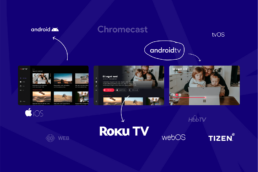In the OTT industry, cross-platform development is not just a token of goodwill. Quite the contrary – by today’s standards, offering an omni-platform app is a must-have, helping brands like Netflix or HBO Go to reach bigger audiences and ultimately get ahead of the competition.
It’s not without reason that the Netflix streaming app is available on dozens of devices and platforms, from very popular ones (like Chromecast, Roku, Apple TV) to some more exotic-sounding set-top boxes or blu-ray players which most people have never heard of. In fact, Netflix is available on so many disparate devices and platforms it’s earned itself a separate entry in wikipedia.
Overkill? Hardly – each aspiring global provider of streaming video should take this path, regardless of the cost.
How many platforms should my app really work on?
Many users of smart TVs or OTT devices are not really aware of which platform they’re using – they just switch on the TV and expect their favorite streaming app to be there. Unless you are remotely interested in technology, you probably have no idea whether it’s an LG TV web-based system or a Sony implementation of Android TV.
Cross-platform development is nothing new. For years, video games have been developed to work on multiple consoles – and most of them are far more technologically advanced than streaming apps. Games are designed for cross-platform play from the start and ported to target devices with a gaming engine. It’s also how You.i Engine One solves for distribution in video app development.
For starters, it’s best to take care of the leading platforms like Roku, Apple TV, Fire TV, Android TV and some web-based smart TV platforms such as Samsung’s Tizen and webOS.
Building the same OTT app for multiple platforms is not only a challenge, but also an additional burden in terms of ongoing maintenance. Excessive cross-platform ambition may throw your development teams into the hell of maintaining the app on each individual device, and take their focus away from developing new features or the product. Naturally, compromises have to be made in terms of which platforms to support. Unless…
The benefits of cross-platform development
The more devices and platforms you deploy on, the higher the complexity, costs, and ability to maintain the apps. Luckily, there are tools which allow you to make native or almost-native apps for these platforms with just one codebase – helping you save some development time and money.
Deploying parallelly on platforms like Roku, Apple TV, or Xbox is a painstaking, iterative process. Among other things, when developing for multiple devices and software platforms, it’s key to maintain a consistent look and feel of the apps, both in terms of graphics and copy. Streaming providers want their apps to look as similar as possible no matter what device is used by the user. The app has to follow the same UX language and use the same user interface, from menus to playback.
While the user may not necessarily notice the difference between how the interface looks on Roku and Android TV, it might be very confusing for those who do – if they own more than one OTT device.
Hardware differences
Fragmentation and hardware differences are the bane of application development, making it hard for companies to develop cross-platform apps. We’ve seen it trouble web browsers and mobile phones before, as developers have been trying to provide the same experience for all the users.
This is basically what’s also happening in the world of OTT. Users expect the same experience no matter the platform they’re using. Creating a unified experience between platforms is essential. However, the four major platforms are far from giving up their hard-earned position for the benefit of developing an industry standard.
Naturally, reaching a point in OTT development where apps are cross-everything might be the best idea, but it is not the easiest thing to execute.
The challenges of developing cross-platform products
Hardware differences generate some of the most important challenges in cross-platform development. Different processing power, screen resolution, aspect ratio or memory across OTT devices can affect how the app performs on a given platform.
Adaptive quality
Managing the quality of content to dynamically adapt the content to slow machines is an intricate process which involves lots of cloud computing and OTT expertice.
Seamless UX across devices
One of the traps of one size fits all approaches in OTT development is getting stuck with low quality design across every platform. However, using certain practices, your UX can incrementally adapt to the OTT device it’s being used on. This process is known as progressive enhancement. The app runs with lower quality on low-end devices, but increases it dynamically to meet the demands of higher-end ones. This can involve specific processes, for example, to avoid low frame rate or long load times, there is no video playing in the background on slower devices.
Better Software Group’s supports cross-platform development with The Better
It is one of the great challenges for any developer to find the right tools or frameworks to develop cross-platform products with minimal effort and resources. At Better Software Group, we give content providers dedicated tools to create, centrally manage, monetize and analyze apps across any device.
Customization options in The Better allow you to adjust the appearance of client applications to multiple devices. You can deploy custom, native applications for dozens of supported platforms from a single, easy-to-use interface. Then you can manage all devices with different native UX adaptation yet as one product at the same time.
Interface customization
The platform was designed to enable easy configuration of both the visual and functional side of the application. Visual editor allows you to adjust the look and feel of most menu items. It’s all possible in real-time without requiring end users to install updates.
Flexible User Experience
Change look and feel with a visual designer. Make the application more dynamic with new skins and additional features (fields, assets, application profile). Take control of your multiscreen apps without assistance of software developers.
Application Lifecycle
Launch and publish applications from the cloud-based console. Manage, update and make versions for profiles and apps in real-time with your own workflow.
Aggregated Analytics
View statistics on application or platform, over time and by region. Access a variety of predefined analytics reports. Integrate with existing analytics platforms for a deeper insight.
User Engagement
The platform allows you to communicate with your users through social media connections and messaging. Send push notifications without running the app or include promotional assets in the application to monetize your content.
Stability
With a centralized platform, you can monitor what is happening within your applications with detailed troubleshooting and in-app logging. Get insight into end-user retention, the amount of usage, per platform, application, or region.
Get in touch
Are you looking to partner with a team of experienced OTT experts to take your cross-platform development to another level? Get in touch with us today!
If you find this article valuable, you can share it on social media →
Read more about the UX/UI subject!
July 20, 2023
The Importance of UX in HbbTV app development
HbbTV plays a significant role in the interactiveness and content enrichement. Care for UX makes it shine, but why?
June 29, 2023
LightningJS takes the development world by storm, but why?
The pursuit of discovering new, powerful tools lead to the rise of Lightning JS. What are the benefits of this popular TV app framework?
September 29, 2022
OTT app creation – how to deliver amazing viewing experiences
It is easy to fall for the branding and advertising so let’s dive into crucial topics for delivering exquisite viewing experiences with every OTT…
Are you looking for a company, that will help you build a TV app?
Leave your email and a short description about your project. We would gladly discuss different cooperation possibilities!





